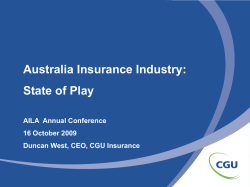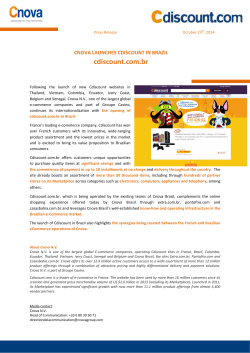
Latin America and the New Phase Thoughts from Brazil
Jornadas Monetárias y Bancárias 2014 Latin America and the New Phase of the Global Financial Cycle: Some Thoughts from Brazil Remarks by Luiz Awazu Pereira da Silva (*) Buenos Aires, November 18, 2014 (*) Deputy-Governor, International Affairs and Financial Regulation, Banco Central do Brasil. These remarks are personal and do not necessarily reflect the opinions of the Banco Central do Brasil (BCB) 1 A Very Old Tale? EMEs in general, Latin America and Brazil in particular, had been, are and might be always riding some phase (up or down, “irrational” exuberance or gloom) of the Global Financial Cycle (GFC) that: • Transmits into our domestic business & financial cycle through several channels (monetary, financial but also “confidence”, that affects our “animal spirits” at home); • Challenges the independence of our domestic policy instruments (e.g., using them in a counter-cyclical way might actually exacerbate financial instability and have unintended destabilizing macro-financial effects , etc.) 22 A Very Old Tale ..... Rejuvenated by UMP? GFC poses perennial issues of relation between macro(price) stability and financial stability (e.g., sudden stops and floods); GFC (with Unconventional Monetary Policy (UMP) in AEs) rejuvenated an equally “old debate” (i.e. should MP be concerned by asset price inflation and more general Financial Stability (FS), the “Lean Against the Wind” vs. “Clean After the Crisis” debate); GFC (for EMEs) unveiled a new analytical and policy issue (i.e. with stronger pre-crisis fundamentals, what’s our capacity to manage excessive volatility of K flows? That might require combining MP and micro+macro-prudential tools) 33 But We Learned By Doing (By Riding).... Post-stabilization Brazil succeeded managing an independent MP, we knew how to handle ups and down of the GFC with standard, textbook recipe (e.g., but fine policy calibration is also an “art”): • Allow ER flexibility to be 1st line of defense; • Accumulate and/or use buffers (reserves, domestic & FX) to smooth excessive market, asset prices, FX volatility; • Use micro+macro prudential policies to complement MP and other policies affecting aggregate demand and the business cycle; • Keep fundamentals strong (debt + banking sector). 44 “Pragmatic” Management of Trinity under GFC Impossible Trinity Fixed Exchange Rate Instruments / Policies Managed / Floating ERR Self-Insurance (Reserves) Pooling Arrangement + IMF Fiscal-Public Debt Management Inflation Target Regime Sustainability & Credibility Independent Monetary Policy Full Capital Mobility Capital Flows Management Microprudential Regulation Some Restrictions & Controls 5 “Separation” Principle Macro / Financial Stability Financial Sector MicroPrudential Policies Aggregate Demand Management Policies Issue Instrument Base CB Rate Inflation & (IT), Monetary Expectations Aggregates Risks to Economic Stability Automatic Activity & Stabilizers & Output Gap Fiscal Policy Exchange Rate Separation Principle Issue Instrument Liquidity problems Liquidity & Reserve Requirements Risks to Balance Sheet Restrictions/ Financial Mismatches Caps on Stability = (Maturity, exposures, Sum of Currency, etc.) etc. Individual Individual Provisonning, Institution' bank's failure Capital Reqts s Problems Choice of ERR, Reserve Acc., Interventions Contagion & Runs Deposit insurance, CB as LOLR Macroeconomic PLUS Financial Stability 6 What’s Really New in the GFC with UMP? What’s really “new” with the GFC when you have UMP (ZLB+QE+FG)(*) in AEs to boost the recovery?: • Our reading in Brazil was that it was a necessary move and policy innovation; nobody wanted to see the counterfactual (a 21st Century Great Depression); • We knew it would have collateral effects on EMEs and Brazil in particular; posing more challenges to our policy independence; exacerbating our local business & financial cycles (*) ZLB: Zero-Lower Bound; QE: Quantitative-Easing through asset purchase programs; FG: Forward Guidance signaling stability of low long-term rates for a prolonged period of time 77 Credit & Asset Price “Transmission” of GFC exuberance? Sources: IMF, International Financial Statistics; Datastream; national data; BIS calculations. Simple average of Argentina, Brazil, Chile, China, Hong Kong SAR, Colombia, India, Indonesia, Korea, Malaysia, Mexico, Peru, the Philippines, Poland, Russia, Saudi Arabia, Singapore, South Africa, Thailand and Turkey. 8 The Colateral Effect is Dealing with Excessive K Flows Unusually intense & volatile capital flows to EMEs Despite FX intervention & sterilization, sudden floods compound boom cycles in local credit and asset markets, including ER appreciation Separation? Lower Credit Standards, Higher Financial Risk Inflation Pressure, Loss of Competitiveness 9 Many Empirical Evidence of Spillovers of UMP Counterfactual exercise using VARs (Barroso, João Barata, L. A. Pereira da Silva and A. Soares (2013)) for Brazil to measure spillovers, externalities during phases of capital inflows Empirical evidence (Rey (2013) of influence of AEs’ MP on various macro-financial variables in other economies even when countries have a flex ERR 10 Riding the GFC with a Standard Textbook Plain Vanilla PF What did we do in Brazil against the ups and downs of the GFC? We prepared ourselves; We knew that excessive exuberance was not going to last; We knew that we had to preserve our policy control over our domestic cycle using our standard, textbook framework and strengthening it with new instruments from our toolkit We kept a standard, textbook PF with known, credible rules: flexible ERR with reserve accumulation (self-insurance), IT framework, sustainable debt levels with fiscal rules, AD management through FP+MP 11 11 New Phase of the GFC, what’s next for EMEs? Now that the US (FED) is seemingly, after ending the “tapering”, considering its next steps, what’s next for EMEs? A popular scenario was, a few months ago, “tale of a death foretold” and/or a “perfect storm”; EMEs having succumbed to “easy money” from UMP, excessive exuberance, tolerated high twin deficits, developed credit bubbles and hence would suffer a severe forced adjustment (e.g., some new creative acronyms were coined such as the “Fragile Five”, etc.); In fact, although there was higher volatility and adjustments after the “tapering tantrum”, most EMEs experienced asset price adjustments, a growth deceleration but were also capable of effective policy reaction. 12 New Phase of the GFC, what’s next in Brazil? And in this new phase of the GFC, what are we doing in Brazil? First we welcome the “tapering”, its orderly end, confirming a steady US recovery; we welcome the much improved communication by the FED of its policies; we note that AEs policies (US, Japan, EU) are not synchronic (that might help); We knew there was going to be a repricing of our assets and consider it is a net positive for Brazil, even if we are expecting more volatility; We put in place a $100 billion dollar buffer to offer FX hedge to our private sector against excessive volatility in FX markets; 13 New Phase of the GFC, Textbook Framework in Brazil We acted early in 2013 to counter our local inflationary pressure, tightening our policy rate by a total of 375bps between April 2013 and April 2014; In its last meeting, our MPC hiked the policy rate by 25 bps. We considered that, among other factors, the intensification of adjustments in relative prices in the economy has made the balance of risks to inflation less favorable. And in moments such as the current one, our MPC considers that the monetary policy should remain especially vigilant. Bottom line: EMEs in general and Brazil in particular can handle spillovers from the GFC even when they are exacerbated by UMP. 14 Lessons? Textbook Policy Framework Complemented By... • Additional Tool (1) during Upswing: MaPs acting as “speed bump” for K inflows; can work well for financial stability and complement MP during QE; possible CFMs (e.g., IMF) • Additional Tool (2) during Reversal: FX buffer acting as “tranquilizer”, important to reduce excessive volatility during “tapering” and its aftermath; possible usage of IMF’s FCLs; perhaps regional buffers, etc. • Challenges: Separation principle (between macro & financial stability) holds but requires good and clear Tinbergen-like communication, 1 objective 1 instrument; MP to address inflation; MAPs to address financial stability issues 15 What About Some “Multilateral Coordination”? “But such (capital) control will be more difficult to work…by unilateral action than if movements of capital can be controlled at both ends.” John Maynard Keynes “Almost every country at one time or another, exercises control over the inflow and outflow of investments, but without the cooperation of other countries such control is difficult, expensive, and subject to considerable evasion.” Harry Dexter White Source: J. Ostry (IMF) 16 16 What About Preventing Financial Instability with Regulation? “thou shalt remember that people forget” the causes of past financial crises and that “thou shalt not rely on self-regulation”. Alan S. Blinder (2013), “After the Music Stopped: the Financial Crisis, the Response and the Work Ahead”, The Penguin Press, New York. 17 17 What about the “political economy” of exuberance? “Bubbles” and “booms” not an exclusive EME issue, many episodes in AEs (e.g. including recent pre-2008 sub-prime, Euro accession, etc.) Regulation as important it might be, might not be enough (complementary package of fiscal + monetary policies) but issues of political economy for implementation (e.g., the perennial of housing booms), with many examples all over the World, in Japan, East-Asia, the Baltics, Eastern-Europe, Peripheral European countries of the Eurozone (notably Spain) housing markets just before, during and after Euro inception, the UK and all above all, the USA, etc. 18 18 My remarks mostly taken from: http://www.cemla.org/PDF/IADB-CEMLA-InflationTargeting.pdf 19 19 References • Agénor, P.R., and L. A. Pereira da Silva (2013),” Inflation Targeting and Financial Stability: A Perspective from the Developing World”, mimeo, Central Bank of Brazil, July 2013 • Barroso, João Barata, L. A. Pereira da Silva and A. Soares (2013)), “Quantitative Easing and Related Capital Flows into Brazil: Measuring its effects and transmission channels through a rigorous counterfactual evaluation”, Working Paper No. 313, Central Bank of Brazil, July 2013 • Blinder, Alan S. (2013), “After the Music Stopped: the Financial Crisis, the Response and the Work Ahead”, The Penguin Press, New York. • IMF (2013), “The Interaction between Monetary and Macroprudential Policies”, January 29, 2013, http://www.imf.org/external/np/pp/eng/2013/012913.pdf • IMF (2013), “2013 IMF Spill-over Report” August 1, 2013, http://www.imf.org/external/np/pp/eng/2013/070213.pdf • Rey, Helène (2013) Dilemma not trilemma: the global cycle and monetary policy independencehttp://www.kansascityfed.org/publicat/sympos/2013/2013Rey.pdf 20 Thank You 21 21
© Copyright 2025









